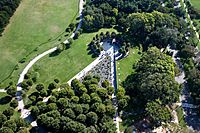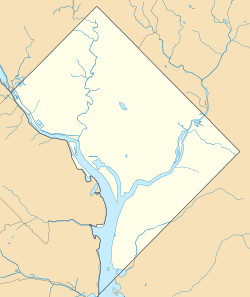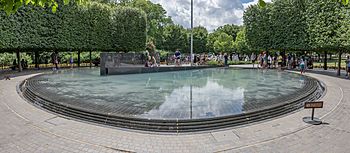Korean War Veterans Memorial facts for kids
Quick facts for kids |
|
|
Korean War Veterans Memorial
|
|

Aerial view of the Korean War Veterans Memorial
|
|
| Location | SE of Lincoln Memorial, off Independence Ave., Washington, D.C. |
|---|---|
| Area | 2.20 acres (0.89 ha) |
| Visitation | 3,214,467 (2005) |
| Website | Korean War Veterans Memorial |
| NRHP reference No. | 01000273 |
| Added to NRHP | July 27, 1995 |
The Korean War Veterans Memorial is a special place in Washington, D.C.. It is located in West Potomac Park, near the famous Lincoln Memorial. This memorial honors the brave men and women who served in the Korean War.
Contents
History of the Memorial
The idea for the Korean War Veterans Memorial was approved by the U.S. Congress on April 20, 1986. A special group called the Korean War Veterans Memorial Advisory Board helped manage its design and building.
At first, a team from Pennsylvania State University won the design contest in 1986. But their design needed changes to please the advisory board. So, a different group, Cooper-Lecky Architects, took over the design. They worked with many designers to create the final look.
President George H. W. Bush started the construction on June 14, 1992. This day is known as Flag Day. Many companies helped build the memorial. It was officially opened on July 27, 1995. This date was special because it was 42 years after the armistice (a peace agreement) that ended the war.
President Bill Clinton and Kim Young Sam, who was the president of South Korea at the time, dedicated the memorial. They honored everyone who served in the war. Today, the National Park Service takes care of the memorial.
Design and Features
The memorial has a unique shape. It combines a triangle and a circle.
The Mural Wall
The main part of the memorial is a long wall. It is about 164 feet (50 meters) long and 8 inches (20 cm) thick. This wall is made from over 100 tons of shiny black granite. More than 2,500 photos are carved into the wall. These pictures show soldiers, equipment, and people who helped during the war. An artist named Louis Nelson created this mural.
When you look at the wall, it seems like there are 38 soldiers. This number is important because the war lasted 38 months. Also, the 38th parallel is the line that divided North and South Korea.
The Column of Statues
Inside the triangle part of the memorial, there are 19 stainless steel statues. These statues were designed by Frank Gaylord. They are called The Column. Each statue is larger than a real person, standing between 7 feet 3 inches (2.2 meters) and 7 feet 6 inches (2.3 meters) tall. Each one weighs almost 1,000 pounds (450 kg).
The statues show a group of soldiers on patrol. They represent different parts of the armed forces. Fourteen are from the U.S. Army. Three are from the Marine Corps. One is a Navy Corpsman (a medical helper). And one is an Air Force Forward Air Observer. They are wearing their full combat gear. They are placed among granite strips and juniper bushes. These plants show the rough land of Korea.
United Nations Wall
Near the statues, there is another low wall called the United Nations Wall. This wall lists the 22 countries that were part of the United Nations. These countries sent troops or medical help to support the Korean War effort.
Pool of Remembrance
The circular part of the memorial holds the Pool of Remembrance. This is a shallow pool about 30 feet (9 meters) wide. It is lined with black granite. Linden trees grow around the pool, and there are benches to sit on. The trees are shaped so that the sun reflects on the water.
Messages are carved near the pool. They list the numbers of soldiers who were killed, wounded, missing in action, or became prisoners of war. This includes both American and United Nations troops. A nearby sign says: "Our nation honors her sons and daughters who answered the call to defend a country they never knew and a people they never met."
On the south side of the memorial, there are three Rose of Sharon hibiscus plants. This flower is the national flower of South Korea. Another granite wall has a simple, important message: "Freedom Is Not Free."
Memorial Maintenance
On October 12, 2015, Samsung Electronics gave $1 million to the Korean War Memorial Foundation. This money helps keep the memorial in good condition. William Weber, the chairman of the foundation, said that parts of the memorial need to be treated twice a year to stay nice. Samsung also helped clean the memorial grounds as part of a company service day.
Troop Statistics
Numbers of those who served are carved on granite blocks near the Pool of Remembrance.
- Dead — United States: 36,574 (in Korea), United Nations: 628,833
- Wounded — United States: 103,284, United Nations: 1,064,453
- Captured — United States: 7,140, United Nations: 92,970
- Missing — United States: 8,177, United Nations: 470,267
Images for kids
See also
 In Spanish: Monumento Conmemorativo a los Veteranos de la Guerra de Corea para niños
In Spanish: Monumento Conmemorativo a los Veteranos de la Guerra de Corea para niños






